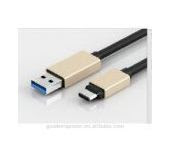We have few personal computers in our houses where they host the USB1.0. The technology has raced ahead and the latest USB standard available is the USB3.1. We all know that USB2.0 works at 480Mbps. But now the USB3.1 works up to 10Gb/s which is called a super speed USB connectivity. We will start seeing PCs and mobiles with these USB3.1 ports in the very near future. USB3.1 basically extends the present existing USB3.0 port standard to a high level, there by almost doubling the speed of the interface. With thunderbolt being implemented on main scale PC devices, at 20Gb/s, USB3.1 speed is comparatively low. there are two versions of USB3.1 stardard named Gen 1 and Gen 2.
Advantages of USB3.1 connectivity:
1. Faster speeds
2. Back ward compatible
3. Power efficient
4. The connector supports 20V/5A for a total of 100W
5. Type C cable is used which is easily pluggable
Practical implementations:
1. USB3.1 or any other technology can never achieve the maximum speed it has been designed for. The cables used and their lengths limit the speed of the technology.
2. The processors should be designed to support this new USB3.1 standard.
3. USB3.1 is compatible with USB Type C standard
4. USB3.1 Gen 1 supports 5Gb/s whereas USB3.1 Gen 2 supports 10Gb/s
5. storage devices that require more data and more speeds may implement USB3.1 technology
What is the difference when it comes to USB2.0?
1. USB2.0 has 1 differential pairs with transactions possible in only one direction. Can be said half-duplex.so, there are in total 2 lines for data transmission in USB2.0. where as the USB3.1 standard uses 2 differential signals (1 Tx, 1 Rx) in addition to USB2.0. So, there are in total 6 signal lines in USB3.1.
2. The transactions between host and device can happen in only one direction in USB2.0 where as the data transmission happens in both directions in USB2.0.
Want to buy an evaluation board with USB3.1 included? check the below link:
http://www.asus.com/microsite/mb/best_usb31_solutions/
https://www.asus.com/Motherboards/H170-PRO-USB-3-1/
http://www.asus.com/Motherboards/RAMPAGE_V_EXTREMEU31/
The above link shows a motherboard available from ASUS with USB3.1 connectivity. The RAMPAGE board from ASUS mounts a Intel Core i7 processor on LGA 2011-v3 socket


